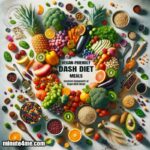Introduction to the Danish Diet
The Danish diet is a healthy and balanced diet that is rich in fruits, vegetables, whole grains, and fish. It is also low in saturated fat and cholesterol, and it emphasizes moderation in the consumption of red meat and sweets.
The Danish diet has been linked to a number of health benefits, including a reduced risk of heart disease, stroke, obesity, and type 2 diabetes.
In this article, we will take a closer look at the Danish diet, including its history, its nutritional profile, and its health benefits. We will also provide some tips for incorporating more Danish dishes into your own diet.
Danish Diet Menu
The Danish diet is a healthy and balanced diet that is rich in fruits, vegetables, and whole grains. It is also low in saturated fat and cholesterol, and it emphasizes fish and seafood over red meat.
- Breakfast:
- Yogurt with berries
- Oatmeal with fruit and nuts
- Whole-wheat toast with eggs and avocado
- Lunch:
- Salad with grilled fish or chicken
- Soup with a whole-wheat roll
- Sandwich on whole-wheat bread with lean protein, vegetables, and fruit
- Dinner:
- Fish or seafood with roasted vegetables
- Chicken or turkey with brown rice and vegetables
- Lentil soup with whole-wheat bread
- Snacks:
- Fruit and yogurt
- Vegetable sticks with hummus
- Whole-wheat crackers with cheese and fruit
Are you looking for a healthy and delicious diet that is easy to follow? If so, the Danish diet may…
Breakfast Foods
Here are some common breakfast foods in Denmark:
- Bread with butter, cheese, and/or jam
- Cereal with milk
- Yogurt with fruit
- Oatmeal
- Eggs
- Fish
- Ham
- Sausage
- Pork
- Beef
- Chicken
- Vegetables
- Fruit
Lunch Foods
Lunch is the most important meal of the day in Denmark, and it is typically eaten between 12:00 and 1:00 PM. A typical Danish lunch consists of a sandwich, salad, and a glass of milk or water.
- Sandwiches
- Open-faced sandwiches with butter, cheese, ham, or meat
- Smørbrød sandwiches with butter, cheese, ham, meat, eggs, fish, vegetables, or fruit
- Smørrebrød sandwiches with a variety of toppings, such as herring, shrimp, or liver pâté
- Salads
- Green salads with lettuce, tomatoes, cucumbers, onions, and carrots
- Potato salads with potatoes, mayonnaise, and bacon
- Salads with fish, chicken, or meat
- Drinks
- Milk
- Water
- Coffee
- Tea
Danish Diet for Diabetes Control
Discover the Danish Diet, a powerful ally in managing diabetes and promoting overall health. Based on the wholesome traditions of…
Dinner Foods
Here are some common dinner foods in Denmark:
- Fish dishes, such as fish soup, fish cakes, and pickled herring
- Meat dishes, such as pork roast, beef stew, and chicken casserole
- Vegetable dishes, such as roasted vegetables, steamed vegetables, and salads
- Potato dishes, such as mashed potatoes, boiled potatoes, and potato pancakes
- Grain dishes, such as rice, pasta, and bread
- Desserts, such as pastries, cakes, and ice cream
Dinner in Denmark is typically a large meal, and it is often eaten with family or friends.
Snacks
Here are some common snacks that are eaten in Denmark:
- Cheese and crackers
- Bread with butter and jam
- Fruit and yogurt
- Hard-boiled eggs
- Vegetable sticks with dip
- Scones
- Pastries
- Chocolate
- Cookies
Snacks are typically eaten in between meals, and they are often a way to refuel after a long day or to satisfy a sweet tooth.
Discover the Danish Diet, a proven path to shedding pounds and enhancing your well-being. This popular weight loss regimen, inspired…
Drinks
The following are some of the most popular drinks in Denmark:
- Coffee – Coffee is the most popular drink in Denmark, and it is often consumed with milk and sugar.
- Tea – Tea is also popular in Denmark, and it is often drunk with milk and sugar.
- Beer – Beer is a popular alcoholic drink in Denmark, and it is often consumed with a meal.
- Wine – Wine is also popular in Denmark, and it is often consumed with a meal.
- Spirits – Spirits are also popular in Denmark, and they are often consumed in cocktails or mixed drinks.
In addition to these traditional drinks, Denmark has also seen a rise in the popularity of healthier drinks in recent years. These include fruit juices, smoothies, and sparkling water.
Desserts
Desserts are an important part of the Danish diet, and there are many different types to choose from. Some popular Danish desserts include:
- Æbleskiver
- Flæskesteg
- Rødgrød
- Kringle
- Wienerbrød
These desserts are all made with fresh, wholesome ingredients, and they are sure to satisfy your sweet tooth.
Tips for Following the Danish Diet
- Eat plenty of fruits and vegetables. The Danish diet is rich in fruits and vegetables, which are packed with vitamins, minerals, and antioxidants. Eating plenty of fruits and vegetables can help you maintain a healthy weight, reduce your risk of chronic diseases, and improve your overall health.
- Choose whole grains over refined grains. Whole grains are a good source of fiber, which can help you feel full and satisfied after eating. They are also a good source of vitamins, minerals, and antioxidants. Refined grains, on the other hand, have been stripped of their bran and germ, which are two of the most nutrient-dense parts of the grain.
- Limit your intake of processed foods. Processed foods are often high in unhealthy fats, added sugars, and sodium. They are also low in nutrients. Eating too many processed foods can increase your risk of chronic diseases, such as heart disease, stroke, and type 2 diabetes.
- Cook more meals at home. When you cook meals at home, you have more control over the ingredients that go into your food. This means you can make healthier choices, such as using healthier oils, limiting added sugars, and choosing whole grains over refined grains.
- Eat slowly and mindfully. When you eat slowly and mindfully, you give your body time to digest your food and feel full. This can help you avoid overeating.
- Drink plenty of water. Water is essential for good health. It helps to keep your body hydrated and functioning properly. Drinking plenty of water can also help you feel full and satisfied after eating.
- Get regular exercise. Exercise is an important part of a healthy lifestyle. It can help you maintain a healthy weight, reduce your risk of chronic diseases, and improve your overall health.
- Get enough sleep. Sleep is essential for good health. It helps to repair your body and mind. Getting enough sleep can help you improve your mood, focus, and energy levels.
- Manage stress. Stress can take a toll on your physical and mental health. Learning how to manage stress can help you improve your overall health and well-being.
- See your doctor regularly. Your doctor can help you stay healthy by monitoring your weight, blood pressure, cholesterol, and other health risks. They can also help you develop a healthy lifestyle plan that is right for you.
Benefits
The Danish diet is a healthy and balanced diet that is rich in fruits, vegetables, whole grains, and fish. It is also low in saturated fat and cholesterol. As a result, the Danish diet has been linked to a number of health benefits, including:
- Reduced risk of heart disease
- Reduced risk of stroke
- Reduced risk of type 2 diabetes
- Reduced risk of some types of cancer
- Improved weight management
- Increased energy levels
- Improved skin health
- Improved cognitive function
Of course, the Danish diet is not perfect. It is still possible to eat a Danish diet and consume too much unhealthy fats, sugar, and salt. However, by following the general principles of the Danish diet, you can enjoy a healthy and balanced diet that is good for your overall health.
Risks
The Danish diet is generally considered to be healthy, but there are some risks associated with it. These risks include:
- A high intake of saturated fat and cholesterol. The Danish diet is high in saturated fat and cholesterol, which can increase the risk of heart disease and stroke.
- A high intake of salt. The Danish diet is also high in salt, which can increase the risk of high blood pressure and stroke.
- A low intake of fruits and vegetables. The Danish diet is low in fruits and vegetables, which can increase the risk of some types of cancer and other chronic diseases.
It is important to note that these risks are associated with the Danish diet in its traditional form. The Danish diet can be modified to reduce these risks by limiting the intake of saturated fat, cholesterol, and salt, and by increasing the intake of fruits and vegetables.
Conclusion
The Danish diet is a healthy and balanced diet that is rich in fruits, vegetables, and whole grains. It is also low in saturated fat and cholesterol. The Danish diet has been linked to a number of health benefits, including reduced risk of heart disease, stroke, type 2 diabetes, and some types of cancer.
If you are looking for a healthy and delicious way to eat, the Danish diet is a great option. It is easy to follow and can be adapted to meet your individual needs. By eating a Danish diet, you can improve your overall health and well-being.
- The Danish diet is rich in fruits, vegetables, and whole grains.
- The Danish diet is low in saturated fat and cholesterol.
- The Danish diet has been linked to a number of health benefits, including reduced risk of heart disease, stroke, type 2 diabetes, and some types of cancer.
- The Danish diet is easy to follow and can be adapted to meet your individual needs.
- By eating a Danish diet, you can improve your overall health and well-being.
FAQ
Q: What is the Danish diet?
A: The Danish diet is a healthy diet that is based on fresh, unprocessed foods. It is rich in fruits, vegetables, whole grains, and lean protein.
Q: What are some of the benefits of the Danish diet?
The Danish diet has been linked to a number of health benefits, including reduced risk of heart disease, stroke, type 2 diabetes, and some types of cancer.
Q: What are some of the challenges of following the Danish diet?
A: The Danish diet can be expensive, especially if you buy organic produce and meat. It can also be time-consuming to prepare, especially if you are used to eating processed foods.
Q: What are some common foods in the Danish diet?
A: Some common foods in the Danish diet include bread, butter, cheese, eggs, fish, fruits, ham, meat, milk, onions, potatoes, salad, sauce, soup, sugar, vegetables, and water.
Q: How can I incorporate more of the Danish diet into my own eating habits?
A: There are a number of ways to incorporate more of the Danish diet into your own eating habits. You can start by making small changes, such as adding more fruits and vegetables to your meals, choosing whole grains over refined grains, and limiting your intake of processed foods. You can also try cooking more meals at home and using fresh, unprocessed ingredients.







